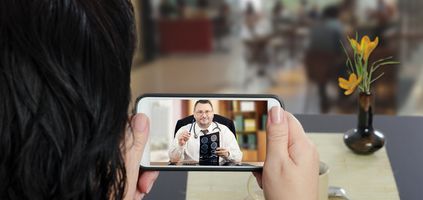Telehealth, telemedicine here to stay, says expert
by April 12, 2020 9:56 am 2,211 views

One of the obvious outcomes of the COVID-19 pandemic is that telemedicine and telehealth will no longer be a wave of the future. They’re here and here to stay.
Gov. Asa Hutchinson loosened regulations on the use of telehealth due to the coronavirus outbreak that had previously limited the ability of doctors, nurses and patients to see one another in person to start a relationship. In an executive order issued in late March, Hutchinson suspended the rules that require a face-to-face meeting to establish a physician-patient relationship.
Arkansas has been one of the last states in the U.S. to allow for liberal telemedicine options. In 2017, a state law was passed to ease into this new era. It required that a first-time visit for a patient had to be in-person with a medical professional. Hutchinson’s order paused that requirement.
“In other words, now a doctor can establish a new patient in his practice over the telephone. This will minimize the number of people in waiting rooms, which, of course, will minimize the spread of the coronavirus as well as flu and other contagious diseases,” Hutchinson said in implementing his order.
The order also suspended the rules and regulations of the Arkansas Board of Examiners in Counseling to allow licensed counselors to treat their clients by telephone. Another significant element of the order is that it allows reimbursement to healthcare providers who take advantage of this provision.
“This is especially important for rural clinics that depend on income from patient visits. The reimbursement provision prevents economic harm to the doctors,” Hutchinson said.
TELEMEDICINE VS. TELEHEALTH
Ray Hanley, the CEO Of Arkansas Foundation for Medical Care, says he expects the usage of technology to become more widely incorporated after the coronavirus pandemic subsides.
He explains that telemedicine and telehealth are two different, yet related, terms.
“Telemedicine is encompassed by telehealth,” he said. “Telehealth is a broad term. Its methods to improve patient care, deliver health education, to help people with remote appointments that can’t otherwise be in the office. It delivers the information, there’s a process to bill for the service. Telemedicine, on the other hand, is remote delivery of healthcare via real-time, two-way communication. Medical information can be quickly exchanged. So it rolls up under telehealth.”
Hanley said the safety features for telemedicine being utilized due to COVID-19 are crucial for controlling the spread of the disease. It keeps patients out of waiting rooms, a result that is likely to be enjoyed by patients after the COVID-19 crisis wanes. Other advantages include reducing transportation costs, increasing productivity for patients who don’t have to wait or travel as long, and it can result in more revenue for medical clinics.
“It wasn’t so much the technology that wasn’t ready. It was probably the payers that weren’t ready because what happened last week because of the pandemic, Medicare changed its policies to allow the health professionals to provide telemedicine to Medicare to be reimbursed,” Hanley said.
“Prior to that change, you could only do telemedicine if you had a prior relationship with a patient, an already established patient, which didn’t exist with a lot of patients. Now, it’s been broadened to make it a lot easier. Now, Medicaid has done a really good job of opening up telemedicine for a lot of provider types, and I think a lot of that can still be here once this is hopefully over,” he added.
Major corporations with employees across multiple states have been big fans of telemedicine for years. With workers cast wide, they’ve viewed telemedicine and telehealth as a way to reduce costs and a necessity for a far-flung workforce. Hanley agrees.
“It lowers costs for everybody. It’s a chance to share information with your primary care physician that can be imparted on to a specialist if need be. You can even monitor these patients from home with EKGs and pulse measures and blood pressure with the right equipment. It can all be done remotely,” he said.
Lack of broadband will curtail faster adoption in rural parts of the state. And lesser tech-savvy citizens will still have a steep learning curve to take advantage of the technology. But, Hanley sees a way to address systemic, long-term health problems through telehealth once the crisis is tamed.
“I think we’re going to learn to do a lot better job of taking care of chronic diseases through telemedicine in ways that we weren’t prepared to do before everybody moved to learn this. That’s the biggest single thing out right now is because of necessity, because of this pandemic, people turned to telemedicine and they are thinking, ‘I need to learn to do this’.”
Watch more of Hanley’s interview in the video below.
